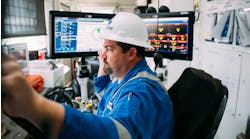Technology transfer program increases production in Venezuela
Jose L. Ortiz-Volcan,Petroleos de Venezuela S.A.
Jay B. Haskell, Schlumberger
Petroleos de Venezuela S.A. (Pdvsa) has engaged Schlumberger's Production Enhancement Group to become a part of its ongoing Metodología Integrada de Productividad (MIP) program by trans-ferring its production optimization technologies and expertise to approximately 300 Pdvsa engi-neers.
The program's objective is to develop technical personnel to identify under-performing wells, select the best technical and economical solutions to optimize production, and then deliver production enhancement recommendations. More than eight mentor courses have been held since summer 2000, training 15-16 Pdvsa engineers during each course. The engineers identified nearly 400,000 b/d of increased incremental production in various fields. To date, about 11% of that increase has been implemented.
Pdvsa engineers worked to enhance the production of 10 fields.
The program is scheduled to last through early 2003. The engineers are applying their new skills to projects in the field by interacting with colleagues on a daily basis. This approach provides feedback that dramatically improves the learning process and the implementation of the recommendation.
The PEG Mentor program, as Schlumberger calls part of this process, is designed to complement the Pdvsa Knowledge Community that provides technical skills in several areas, including integrated production engineering, which encompasses the well productivity stage and surface processing up to the sales point, including subsurface-surface integrated automation. The basic mentor course trains engineers in the use of techniques and software systems that can help identify production optimization opportunities and design the best economic solutions. PEG mentors use their specific expertise not only to help the Pdvsa engineers realize quicker solutions, but also to help them to recognize that solutions are available in an integrated way.
The MIP program facilitates the interrelation between the Pdvsa engineers and the Schlumberger mentors, as well as mentors from two other companies and internal Pdvsa mentors, virtually guaranteeing positive results during the course of each program. Additionally, once the Pdvsa engineers return to their respective areas, they will have the capability to carry out the production enhancement work with the same quality and focus as during the course. This provides an added value for Pdvsa's future.
Each Pdvsa engineer designs and applies optimization solutions to a chosen field as the course progresses. While PEG mentors assist in identifying the candidate wells, the Pdvsa engineer is responsible for the final selection and the field results achieved. After guiding the engineers through selection, design, and execution routines, the PEG mentors assist in conducting a follow-up evaluation of the results.
The mentor helps engineers to apply software programs that analyze historical performance and determine production anomalies. Among the software used during an analysis are FracCADE, SandCADE, StimCADE, and CoilCADE. These routines help identify those production optimization candidates with maximum potential and lowest risk. The engineer carries out a production system analysis to derive actual versus theoretical well productivity comparisons, illuminate areas of low recovery and efficiency that might benefit from new production optimization technologies, and pinpoint mechanical problems to be solved.
The MIP program consists of seven basic steps to recognize the correct production enhancement methods:
- Reservoir and production system overall review
- Screening process and identification of opportunities
- Detailed well review
- Production system evaluation
- Solution to increase production
- Economic evaluation
- Execution of the recommendation.
Modules include the investigation of produc-tion enhancement solutions for reservoir problems, completion performance, flow conduit performance, artificial lift performance, and surface separation and facilities. Best practices are discussed on topics as broad as perforating and re-perforating, controlling sand, squeezing cement, removing scale, replacing tubing, resizing chokes, completing with coiled tubing, using the range of pumps, and optimizing surface facilities operations. A variety of potential optimization techniques are offered in the MIP program to expose the engineers to the many solutions currently available.
Techniques for reducing operating costs as well as the overall importance of good field economics are also learned. Decision tree and probability indicators are taught to familiarize participants with good workflow processes and economic analysis. The engineers learn to assess risk and determine its effect on the overall project.
The Pdvsa engineers begin by prioritizing the reservoirs and initiating a production enhancement review to determine production anomalies and candidates for increased production. They gain an overview of the reservoir under analysis to confirm production enhancement candidates from the screening process. Topics covered include well file reviews, pressure data analysis (permeability, skin, productivity index, etc.), cased hole logs, applications and limitations, geological and petrophysical reviews, reserves on a per-well basis, and a production history review.
The engineers develop their skills using Nodal analysis to optimize well production systems by diagnosing and identifying system bottlenecks that restrict production or injection. They also identify how elements of the well's production system are interrelated, and how they affect performance of the entire production system.
When a technical alternative has been identified, an economic evaluation is performed in order to confirm the viability of the recommended work. A decision tree analysis is performed to select the best alternative from an economical point of view. Different scenarios are built considering several alternatives and the risks associated with each.
Program participants reinforce their supervisory skills as they execute the chosen technical approach. Proposed work is performed with mentor supervision to ensure that the technical requirements are met and the production enhancement is optimized.
Case Study
Several PEG Mentor courses have been conducted in Venezuela. A number of these recommended production enhancement and optimi- zation plans have been implemented in various fields with good results, including the first MIP Caracas I course April-August 2000.
The 15 Pdvsa engineers who participated in the inaugural PEG Mentor course in summer 2000 had from 3 to 11 years experience. They were working to enhance the production of 10 fields: El Furrial, Pirital, Carito, Tia Juana Lago, Lago Cinco, La Salina, Apure, Anaco, Lagomar, and Bachaquero Lago. A potential increase in oil production was identified from 127,400 b/d to 238,500 b/d. The proposed methods to obtain this increase were to perform 30 reperforations, 31 hydraulic fractures, 32 matrix stimulations, 10 changes in artificial lift methods, 14 new wells, 16 workovers, and 17 water control jobs.
Two main reservoirs in the Bachaquero field were considered for production optimization, the Basup 57 and Bainf 59. The latter reservoir consists of unconsolidated Miocene sands and is producing through 31 wells, including 29 with gas lift and two with natural flow. Oil production was 5,500 b/d with 56% water cut. Nineteen opportunities were identified for production enhancement candidates during the initial screening. The primary production anomalies were high initial oil production rates followed by a sudden decrease to low production levels in a six-month period. Water production problems occurred in other wells but it was recognized that this was mainly due to bad primary cementation.
The initial screening resulted in the identification of several production enhancement and optimization opportunities. They included:
- Stimulating low productivity wells
- Applying sand control methods
- Identifying undrained zones based on remaining reserve maps
- Identifying low-pressure, compartmentalized zones
- Changing artificial lift methods
- Detecting bottlenecks in surface facilities.
The wells were reviewed following the integrated productivity methodology, and a detailed well review was begun. During this process, well performance was determined using Nodal analysis. The skin mechanism was established using StimCADE and SPAN software. The result was a detailed evaluation on a well basis that resulted in a portfolio of production enhancement and optimization opportunities.
Pdvsa engineers identified several production enhancement opportunities via hydraulic fracturing. Nine wells have been fractured. Although fracturing had been used in this field previously, fracture conductivity values above two dimensionless compare with lower values used before production enhancement.
Production in the Bachaquero field for a new well was established at 900 b/d. Applying the production optimization methods, production now averages 4,000 b/d, a 344% increase in output.
It is obvious from the results of the implemented production enhancement and optimization plan that the technology transfer is successful. One of the primary objectives of the program is to develop technical personnel skilled in the identification and exploitation of under-performing wells. When Schlumberger began working with Pdvsa in 1993, Schlumberger was identifying potential production enhancement opportunities. Today, Pdvsa engineers identify the opportunities.
The results-driven, learning-by-doing, tailor-made approach to the program has not gone unnoticed. A similar program is being organized and implemented by Schlumberger personnel for Pertamina, Indonesia's state oil company.
Authors
Jose L. Ortiz-Volcan has been with Pdvsa his entire career, with field, technical, supervisory, and management responsibilities in the areas of production engineering, reservoir engineering, reservoir development projects, petroleum computer applications, automation projects, and total quality engineering.
Jay B. Haskell began his career with Schlumberger in 1979 as a field engineer and has held various management positions throughout North America, Asia, Australia, South America, and Mexico.




